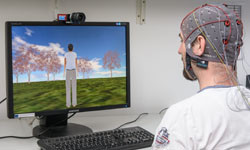Novel mental fatigue detector
Deterioration of selective attention is a sign of mental fatigue and this reduces the efficacy of rehabilitation. EEG activity helps identify differences in the processing of attended and unattended information but is plagued with issues such as low signal-to-noise ratio and unreliability. Visual signs of mental fatigue include changes in eye blinking rate and pupil diameter. Video monitoring coupled with EEG activity could thus prove to be more effective than EEG-based systems alone at detecting mental fatigue. To realise this, the EU-funded 'Quantification of mental fatigue by means of visual and physiological measures' (QFATIGUE)(opens in new window) project was initiated. Researchers simultaneously recorded EEG signals and frontal videos of the face of volunteers during several walking tasks in a robotic gait trainer. They processed videos and extracted data such as eye blinking statistics and relative distances between eye components and eyebrows. Besides noise and artefact removal of EEG signals, the power spectral values of different cortical regions in standard brainwave bands were used as a measure. Power spectral values were selected as they demonstrated significant differences between non-fatigued and fatigued brain activity. Combining the two modes resulted in a multimodal fatigue model that effectively detects fatigue. The results were disseminated through several papers as well as presentations at conferences. QFATIGUE tools should prove to be an invaluable resource in optimising time-intensive rehabilitation procedures and adapting them to individual patient needs. Such personalised rehabilitation regimens should increase patient compliance and improve outcomes.







